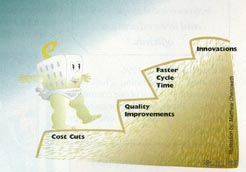 To outsource or not to outsource — that is not the question. You can never be too thin, it seems, in these downsized days. ?Doing it all? has become tantamount to not doing it all effectively. Scattershot diversification is as obsolete as O.J. Simpson?s viability as a corporate spokesperson. Instead, the big business question is maximizing the value and effectiveness of outsourcing, an idea whose time has come.
Moreover, the outsourcing surge redefines subcontracting?s stereotype: the sure sign of a big company?s big troubles. Large and small firms alike are heavily outsourcing, including blue bloods like Compaq, DuPont, Ford, General Motors, Honda, Microsoft, Nike and Sun Microsystems.
Transactions out the DoorIt doesn?t take Stephen Hawking to fathom real estate?s major role in outsourcing?s passion play: For most firms, real estate trails only labor as a cost item, making up one-fourth of total assets, according to the Atlanta-based International Development Research Council (IDRC), a prestigious association of corporate real estate executives and service providers. Moreover, transactional real estate services are virtually flying out of house: 60 percent of real estate executives recently surveyed by Site Selection anticipated increased 1997 outsourcing of brokerage, followed by design/construction (48 percent), architectural services (40 percent), site selection (36 percent), and environmental consulting and facility planning (both at 32 percent). Outsourcing real estate transactions is often compellingly cost-effective. ?Nobody can afford to have 50 people sitting around, often in the wrong place,? says Frank Wyatt, assistant vice president for Europe/Asia-Pacific real estate for Nortel, which is increasingly outsourcing of design, transactions and facilities management. Facility management, in fact, is such an outsourcing hotbed that Ernst & Young has subcontracted all administration and support staff at a Washington, D.C., pilot facility. Subcontracting Goes StrategicLike other subcontracted functions, real estate outsourcing is entering more strategic arenas, with long-term alliances delivering high-volume, lower-priced services. But alliances can boost other strategic goals, including quality, innovation and faster cycle time, IDRC research indicates. After a one-to-three-year learning curve, skilled subcontractors have a clear edge over new, unschooled providers. Strategic alliances rule real estate?s partnering hierarchy. But as with the much-misused corporate reengineering, strategic is gratuitously grafted onto most anything remotely related to supplier alliances. Says one real estate veteran, ?I think a lot of guys want to show their bosses their name and strategic together.? ?Most service provider relationships are not strategic alliances, but preferred or exclusive provider relationships,? the report explains. Many alliances fall short of strategic status, the report contends, lacking ?pooled technology, at a minimum online information systems,? plus ?mutual performance fees.? Case StudiesThe April/May 1997 SS reviews a number of alliance strategies, including: Preferred provider relationships: First Cut Foods slashed transactional costs by signing two-year, narrowly focused preferred provider agreements. Two outside firms give FCC ?single point accountability? for brokerage only, handling all acquisitions, appraisals, dispositions, and market and operating cost analyses. Exclusive provider relationships: Ameritech formed a group of exclusive provider relationships. Five outside master planners were picked to slash per-employee administrative space from 450 sq. ft. (41 sq. m.) to 200 sq. ft. (18 sq. m.). Ameritech signed five-year design and construction agreements with ASC Services and Steelcase?s Furniture Management Coalition. Transactions and administration were outsourced to Equis, while Johnson Controls manages technologically complex facilities, and LaSalle Partners manages assets. ?Bundled? strategic alliances: Sun Microsystems charges its service providers with coordinating themselves to deliver specified real estate outcomes, freeing in-house real estate to concentrate on value-adding strategic concerns. Sun and its suppliers work under shared rewards and recognition, also sharing contractual agreements in areas like planning, organization and quality management. Bundling alliances, says Vice President of Real Estate and the Workplace Bill Agnello, avoids ?a subordinated vendor relationship that stymies innovation.? But he cautions, ?We think this is the most intelligent way to buy real estate services. The question is, is the [service provider] industry at this point ready for it?? Problem AreasOther outsourcing alliance problems include union opposition, which triggered recent strikes at Ford and General Motors. Slow progress is another, perhaps unavoidable problem. For example, more than half of SS-surveyed executives rate support providers? ?overall strategic real estate alliance-related skills? as merely ?fair? — topping the combined ?excellent? and ?good? ratings. If the results were a four-point grading system, none of real estate?s major supporting players rate even a ?B? average; only site selection consultants and local service providers score above a mid-?C.? Outsourcing hype can also create exaggerated cost expectations. Even a study by the Outsourcing Institute, an outsourcing industry arm, puts average savings at 9 percent, well below the 20 to 40 percent some suppliers promise. Real estate?s savings/quality scenario seems uncertain. Almost half of SS-surveyed executives say they ?don?t yet know? outsourcing?s cost impact; and 43 percent say outsourcing has had ?no effect? on work quality. Those results may partially reflect the learning curve among U.S. companies, which often take patchwork approaches that emphasize short-term savings. Strategy Stays HomeBut there is seeming consensus over which real estate elements should be anchored in-house. In short, it?s the strategy, stupid. Ideal outsourcing, says Margaret Carter, a senior manager with Arthur Andersen Real Estate Advisory Services, cuts costs, enhances quality and allows lean in-house operations ?to focus on mission-critical activities.? Identifying what?s ?mission-critical? is an outsourcing strategy key. ?Real estate?s core functions are strategy, planning and process management,? says Larry Ebert, Ernst & Young director of real estate services. ?That?s our focus.?
The Strategic Alliance Report Card:
|
 Subscribe to Site Selection Magazine
Subscribe to Site Selection MagazineFeedback]|[
Search for
any topic]
Copyright 1997 Conway Data, Inc. All rights reserved
Legal Notice: Because data comes from many sources, Conway Data
can assume no responsibility for accuracy or currency.


